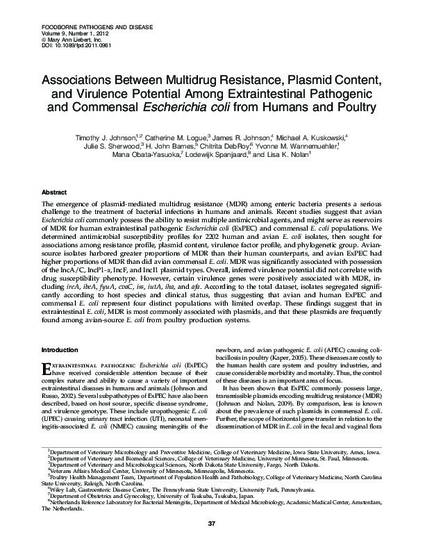
Article
Associations Between Multidrug Resistance, Plasmid Content, and Virulence Potential Among Extraintestinal Pathogenic and Commensal Escherichia coli from Humans and Poultry
Foodborne Pathogens and Disease
Document Type
Article
Disciplines
Publication Date
1-4-2012
DOI
10.1089/fpd.2011.0961
Abstract
The emergence of plasmid-mediated multidrug resistance (MDR) among enteric bacteria presents a serious challenge to the treatment of bacterial infections in humans and animals. Recent studies suggest that avianEscherichia coli commonly possess the ability to resist multiple antimicrobial agents, and might serve as reservoirs of MDR for human extraintestinal pathogenic Escherichia coli (ExPEC) and commensal E. coli populations. We determined antimicrobial susceptibility profiles for 2202 human and avian E. coli isolates, then sought for associations among resistance profile, plasmid content, virulence factor profile, and phylogenetic group. Avian-source isolates harbored greater proportions of MDR than their human counterparts, and avian ExPEC had higher proportions of MDR than did avian commensal E. coli. MDR was significantly associated with possession of the IncA/C, IncP1-α, IncF, and IncI1 plasmid types. Overall, inferred virulence potential did not correlate with drug susceptibility phenotype. However, certain virulence genes were positively associated with MDR, including ireA,ibeA, fyuA, cvaC, iss, iutA, iha, and afa. According to the total dataset, isolates segregated significantly according to host species and clinical status, thus suggesting that avian and human ExPEC and commensal E. coli represent four distinct populations with limited overlap. These findings suggest that in extraintestinal E. coli, MDR is most commonly associated with plasmids, and that these plasmids are frequently found among avian-source E. coli from poultry production systems.
Copyright Owner
Mary Ann Liebert, Inc.
Copyright Date
2012
Language
en
File Format
application/pdf
Citation Information
Timothy J. Johnson, Catherine M. Logue, James R. Johnson, Michael A. Kuskowski, et al.. "Associations Between Multidrug Resistance, Plasmid Content, and Virulence Potential Among Extraintestinal Pathogenic and Commensal Escherichia coli from Humans and Poultry" Foodborne Pathogens and Disease Vol. 9 Iss. 1 (2012) p. 37 - 46 Available at: http://works.bepress.com/lisa_nolan/35/

This is a copy of an article published in Foodborne Pathogens and Disease © 2012 Mary Ann Liebert, Inc; Foodborne Pathogens and Disease is available online at http://online.liebertpub.com.